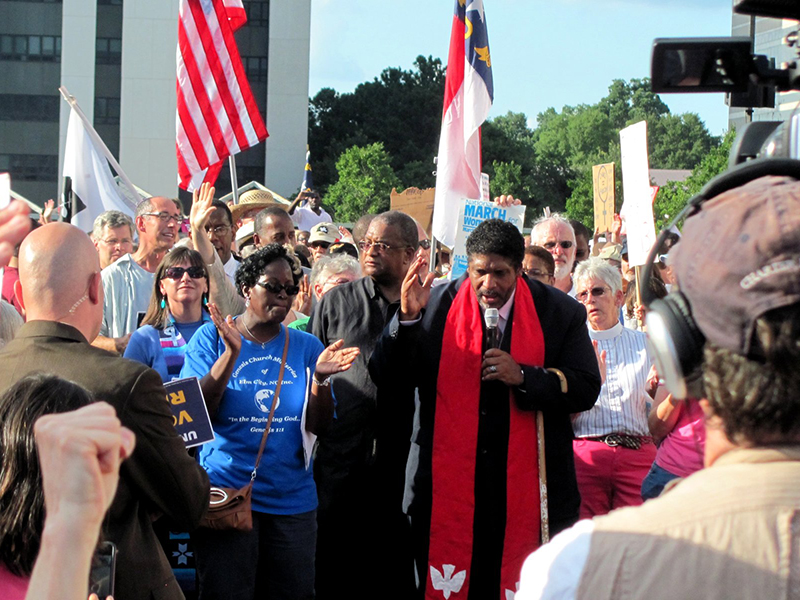The Injustice of the Unhoused
Re-Moralizing Monday

Reflections on a Decade of Witness
By Rodney Sadler
I prayed two times on Monday…
Monday, April 24, was quite a remarkable day, all told, when I think about the fractured nature of our world—the divisions among our nation’s peoples, the conflicts that seem almost insurmountable. I got to participate in two moments of union in one day. Most of my days don’t tend to be as splendid as this one was.
Monday began with a trip to Uptown Charlotte for the GreenFaith witness-bearing outside the Bank of America Tower. It was a wonderful gathering of rich and poor, young and old, White and Black and Latinx and Asian American and Indigenous peoples. We came together to sing a common song, to dance to a common rhythmic drumbeat, to raise many voices in a common chant. We came together not in anger or contention, but with an ardent, reasoned plea, calling on the nation’s largest bank and through them to all banks to stop funding new fossil fuel infrastructure.
This seems like such a simple request, particularly given BofA’s own stated goals to reorient its investments away from fossil fuels toward renewable energy sources. The goal was to support the notion that the bank’s board members will vote to prioritize renewable energy investments. Each witness-bearer who spoke or sang or danced or rapped or poured libations did so with the common message that we have to support the planet and its people over corporate profits.
I was blessed to be able to pray the opening prayer for the event, in which I offered confession that we are all guilty of relying on fossil fuels, of participating in the creation of the problems we are now seeking to address. I began with repentance. I then called on our common Creator to help us make reasoned choices that will invest in a 100% renewable energy future with targeted shifts in our modes of energy production that will incentivize hiring Black and Brown peoples left on the margins of our current economic model for jobs that pay a living wage. My prayer was that we take advantage of the crisis to provide an opportunity for a just future.
It was good to see the faces of so many friends who are activists in the climate and environmental justice movements. Some of them I have not seen face to face for some three years, as we have been largely sequestered because of the pandemic. I think I was as uplifted by the handshakes and hugs as I was by the humanitarian message.
I left that movement moment before it was over. I had to pick up friends as I headed to a rally in Raleigh. (I always get tickled by the care needed to pronounce those two words with clarity, lest they be conflated, confused, or incomprehensible.) This rally was for the 10th anniversary of the Moral Monday movement.
It was actually on April 29, 2013, that Rev. Dr. William Barber II and 16 of his colleagues went into the General Assembly Building at 16 Jones Street to bear witness to their elected officials that the legislation they were passing was harmful to the citizens of our great state. After the 2012 elections, a red wave had swept through our state. In one fell swoop, the North Carolina house, senate, and governor’s mansion all were dominated by right-wing extremists, drunk on the wine of power and completely uninhibited by sober thought or consideration from passing the most regressive policies of the American Legislative Exchange Council (ALEC). In response, the 4/29 17 went into the General Assembly Building, carried signs, sang songs, prayed prayers, and were arrested for bearing witness to God’s justice. Thus began the Moral Monday movement.
I was supposed to have been in that number, but I was riding to Raleigh with my local NAACP president, Kojo Nantambu, and he was still struggling with pneumonia that day. I could have gone alone, but my daughter was recovering from a cold, and her mother was on the road with her prison abolishment work. I was supposed to be there, but perhaps I was insulated from having to make a courageous choice in the moment by the (however legitimate) exigencies of that day.
The next week I was on the way there, riding with a recovered Kojo and an inspired Dr. Peter Wherry. We made it to Davie Street Presbyterian Church, where we were “encouraged” by Dr. Barber and trained by attorney Geeta Kapur to surrender ourselves for civil disobedience. There was concern that the actions of a week before were those of a radical group of Black ministers and aging hippies who would quickly lose interest and momentum—at least that’s what the extremist legislators thought—but the three of us were joined by 27 others, including William Barber III, then a college senior, three former presidents of the American Historical Association, several doctors and lawyers, and other clergy and impacted people.
We were arrested while praying and singing outside the doors of the House of Representatives. I remember the chief of police of the General Assembly personally arresting me…waiting patiently for me to complete my prayer with an appropriate “Amen” and then embracing me with a hug before asking for my hands to put them in shackles. Also a man of faith, he was caught in the moral ambiguity of the moment—caught between the job he had sworn to do, his Constitutional commitment to protect free speech, and his theological certainty that God had called us to do something more.
Well, from 17, to 30, to 49, to 54, to151, the numbers of arrested kept growing by the week. Over the course of 13 weeks, more than 1,000 people were arrested for bearing witness at the General Assembly building and at the Capitol. The movement was in full swing and soon developed a healthy court component, with trials that resulted in the exoneration of arrestees, freeing them to return to “our house,” and vacating trespass orders, and opposing repressive laws like the “Monster” Voter Suppression Bill, passed the day after the Shelby County v. Holder ruling was handed down in the Supreme Court. Under Dr. Barber’s leadership, the Moral Monday movement had become a living, breathing thing that was impacting the world.
That was 10 years ago. On Monday, April 24, 2023, we joined together not just to celebrate past victories, but also to recommit ourselves to this struggle. I was blessed to be able to offer the opening Christian prayer for the event after my sister in the struggle Rabbi Lucy Dinner offered a Jewish prayer. My prayer was that we not only commemorate what we did 10 years ago, but that we recommit ourselves to the work of bringing God’s justice to our state, our nation, and our world! I also recalled the memories of the many who had come and many others of our dear compatriots who had already gone to glory…people like T. Anthony Spearman, Jade Jackson, Frank Jones, Daphne Johnson, Charles van der Horst, Rosanell Eaton, and so many others who were sorely missed in our number. But they are receiving God’s reward for their lives well lived!
Our prayers were followed by amazing testimonies from impacted speakers and union organizers and grieving mothers and struggling workers and young activists and a host of others. Of course, this was all punctuated, quite fittingly, by Rev. Dr. William Barber II, who brought home the call for recommitment and the need to both come back to Raleigh and to take the movement back to our homes across North Carolina.
After the rally, which was held outside the Capitol building, we marched to the General Assembly building to deliver a list of demands. The list was, in essence, the manifesto of a renewed movement. The handiwork of lawyer Caitlin Swain, it read like a declaration of independence in its eloquent demand for human rights. After marching three by three to the building, we found out that we were not permitted to approach the doors to drop off the document. No matter. Dr. Barber stood at the gate, contemplated jumping over it as an act of civil disobedience, and then decided instead to distribute the demands to the crowd. As he began to read the demands out loud, organically, without instruction, the crowd began to read along with him. Our unity was evident as we, with one voice, expressed the concerns of the citizens of North Carolina. We read together. We were together. Forward Together, Not One Step Back!
Reluctantly, the crowd disbanded on that day—tired, physically and emotionally; inspired, spiritually; and oriented on a justice trajectory. The gathered crowd consisted of many of the members from a decade ago…some now on walkers—so many walkers this time—but they came anyhow! We were supplemented by so very many new people, including a number of first-timers. Even students.
I was assured as I left that the movement had not died after the initial 17, after the first-year arrests of more than a thousand, after the three years of steady protests, or even after about a seven-year hiatus. No, this intersectional fusion moral movement lives on. I am just glad I got to be in the number one more time and to pray two prayers (among the host of others uttered throughout the day) that justice be done and that God’s kingdom/kindom would come on earth as it is in heaven!
May we ever pray prayers with our lives and march prayers with our feet and work prayers with our hands that, in our divided land, justice will finally be done!
Rodney S. Sadler Jr.’s teaching experience includes courses in biblical languages, Old and New Testament interpretation, wisdom literature in the Bible, the history and religion of ancient Israel, and African American biblical interpretation. His first authored book, Can A Cushite Change His Skin? An Examination of Race, Ethnicity, and Othering in the Hebrew Bible, was published in 2005. He frequently lectures within the church and community on Race in the Bible, African American Biblical Interpretation, the Image of Jesus, Biblical Archaeology, and the Dead Sea Scrolls. He was the managing editor of the African American Devotional Bible.
Dr. Sadler served as a visiting lecturer and interim co-director of the Office of Black Church Studies at Duke Divinity School in Durham, North Carolina, and was an associate minister in Durham, North Carolina. He is the director of the Center for Social Justice and Reconciliation on the Charlotte campus of Union Presbyterian Seminary.
Article image CC-BY license on Flickr: – https://www.flickr.com/photos/twbuckner/9295256177/

